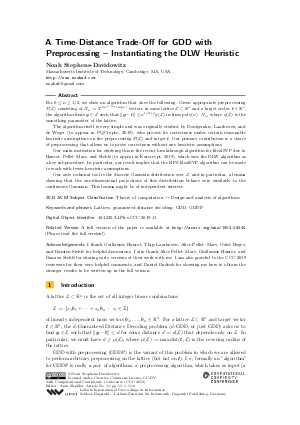@InProceedings{stephensdavidowitz:LIPIcs.CCC.2019.11,
author = {Stephens-Davidowitz, Noah},
title = {{A Time-Distance Trade-Off for GDD with Preprocessing - Instantiating the DLW Heuristic}},
booktitle = {34th Computational Complexity Conference (CCC 2019)},
pages = {11:1--11:8},
series = {Leibniz International Proceedings in Informatics (LIPIcs)},
ISBN = {978-3-95977-116-0},
ISSN = {1868-8969},
year = {2019},
volume = {137},
editor = {Shpilka, Amir},
publisher = {Schloss Dagstuhl -- Leibniz-Zentrum f{\"u}r Informatik},
address = {Dagstuhl, Germany},
URL = {https://drops.dagstuhl.de/entities/document/10.4230/LIPIcs.CCC.2019.11},
URN = {urn:nbn:de:0030-drops-108331},
doi = {10.4230/LIPIcs.CCC.2019.11},
annote = {Keywords: Lattices, guaranteed distance decoding, GDD, GDDP}
}

 Creative Commons Attribution 3.0 Unported license
Creative Commons Attribution 3.0 Unported license















